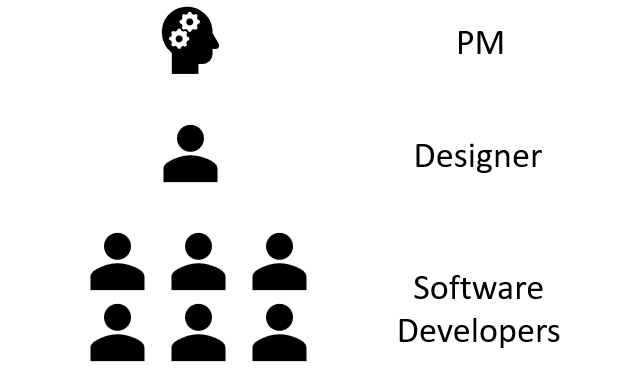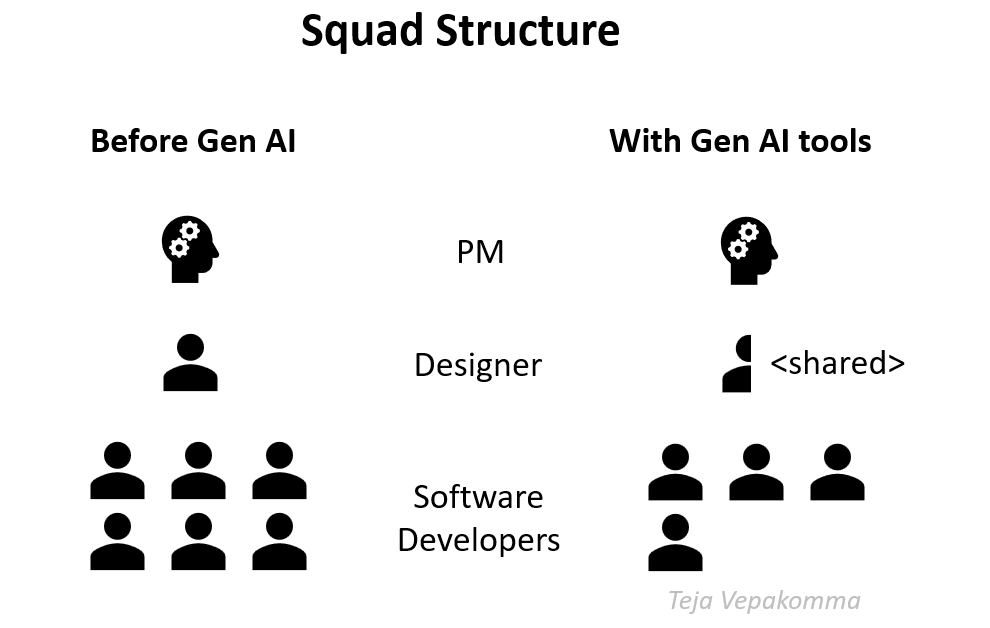Structuring Product Squads in the Gen AI era
How should Product Squads be structured given that Software Engineers and Designers are more productive with Generative AI tools? Read on..
One of the most valuable resources for a tech product company is its people. Structuring teams correctly can have a significant impact on productivity and resource utilization.
Current Squad Structure
If you are like most modern Software Product companies, you organize your teams as Product Squads. Each Squad comprises of Software Engineers, Designers and Product Managers. This is what a typical team structure looks like:
Of course, the exact number of Engineers and Designers per squad will vary by the nature of the industry, competitiveness, lifecycle stage and tech stack. There may be additional shared resources like Marketers, Data Analysts, etc. supporting the squad. For the purpose of this discussion, we will be focusing on PMs, Designers and Engineers only.
Impact of Gen AI on Squad Roles
Let’s look at the impact of Generative AI on each of the 3 major roles in a Product Squad:
Software Developers: Software Developers are more productive today with code generation tools like GitHub Copilot, Replit, Cursor, etc. In the Gen AI era, the focus of Software Developers will be more on architecture, reviews of AI generated code, and solving hard problems. More experienced (and fewer) developers will be needed for these tasks. Of course, the quantum of productivity gains will depend on factors specific to your product (e.g. Legacy code vs New code, dependencies, etc.) but various studies have pegged the average productivity gains at 35% for Software Developers.
Designers: Today AI can generate on-brand designs. Designers can now scale using AI tools like Uizard, Galileo, and Figma AI. PMs can quickly create prototypes that can be converted into code (instead of creating user stories). However, a Designer is still needed to ensure production quality designs are shipped. Due to Gen AI driven productivity gains, we will need fewer Designers on a squad. Various studies have pegged the average productivity gains at 40% for Designers.
Product Managers: A Product Manager’s job is to ensure maximum customer value is derived from features being developed. This requires
a) Research, Analysis & Prioritization
b) Scoping & Definition
c) Review & Approval of Design & Development
d) Customer Adoption & Refinement
Among all of these tasks, Scoping & Definition is the only one that can be sped up to a significant extent by Generative AI. Generative AI can help marginally speed up some research & analysis tasks as well, but human oversight will be required.
For Gen AI feature development, PMs will have to perform additional tasks such as Model performance, price, bias and hallucinations evaluation & management.
All of these mean that Product Managers have a lot more to do in the Generative AI era and the net productivity gain for PMs maybe zero.
Squad structure with Gen AI Assistants
If you have empowered your Product Squads with Generative AI tools like the ones described in the section above, you may want to rethink your squad sizes due to potential productivity gains. A word of caution: It may take some time for your team to achieve productivity gains and the quantum of gains varies by a number of factors. Here’s how would a Product Squad would look like before and after Generative AI assistants:
Note that we have reduced Developers by 33%, Design by 50% and PM strength remains the same. The reason for this is detailed in the section above. But in general, PMs are expected to now create prototypes, which can then be converted into user stories or code.
Other Roles with Gen AI assistants
Other roles on a squad like Project Managers may not be needed unless you have complex dependency tracking requirements on other teams. However, with AI generated code, you need to rethink if you want to have shared components in the architecture (therefore creating dependencies and slowing down the teams) or if you prefer each team to generate and maintain their own platform.
A note on Hierarchy in the Gen AI era
Your squads are more productive and able to create more software. How do you ensure they are working on the right priorities and that they are producing the right customer outcomes? That’s where managers come in. If your squads are lead by a PM, you will need PM Managers to manage multiple squads to ensure they are working on the right priorities tied to the company goals. This is absolutely critical and often overlooked leading to wastage of resources.
It is more critical in the Gen AI era to work closely with customers so that innovations are relevant to what customers need. You may want to embed Solutions Consulting / Account Managers / Pre-sales teams along with your PM Managers so that squads are solving the right problems in the right way and limitations with Generative AI are identified early to avoid wasted effort.
Conclusion
Generative AI tools offer maximum productivity gains for Software Developers and Designers as they produce tangible outputs that can be automated. Since Product Managers are involved in producing intangible outcomes (like Customer Value) and complex measurable gains (like customer and revenue growth), it is hard to automate the tasks a PM performs. PMs are also required “humans in the loop” for review and approval at every stage (Design, Development, Deployment, Customer Adoption etc.).
Aim to reduce your squad strength by 30-40% for Software Developers and Designers. Keep PM strength the same. PMs should focus more on customer value and outcomes and rely on AI tools for documentation and project tasks. Ensure co-innovation with customers and customer facing teams. Embed customer facing teams with PM Managers who are responsible for 3-4 squads.
Do share your thoughts in the comments below.
About the Author
Teja Vepakomma is a Product Strategy and Growth consultant to companies. He has many years of experience working in Product Management leadership roles in Global SAAS companies. He’s currently based in Bangalore, India. You can follow or reach out to him on LinkedIn.




